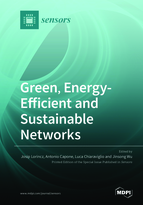Green, Energy-Efficient and Sustainable Networks
A special issue of Sensors (ISSN 1424-8220). This special issue belongs to the section "Internet of Things".
Deadline for manuscript submissions: closed (15 August 2019) | Viewed by 80493
Special Issue Editors
Interests: telecommunications; wired/wireless access networks; energy-efficient networking; sensor networks; Internet of Things; cloud computing; system optimization; renewable energies
Special Issues, Collections and Topics in MDPI journals
Interests: wireless network; radio resource management; network planning and optimization; software defined networks; energy efficient networking; network slicing; network sharing
Interests: 5G networks; Internet for rural and low-income areas; sustainable cloud data centers; optimization techniques
Special Issues, Collections and Topics in MDPI journals
2. Department of Electrical Engineering, Universidad de Chile, Santiago, Chile.
Interests: edge computing; green computing; Artificial Intelligence
Special Issues, Collections and Topics in MDPI journals
Special Issue Information
Dear Colleagues,
The topic of “energy-efficient networking and computing” is attracting growing attention for economic, energetic, and environmental reasons. According to a number of studies, Information and Communication Technologies (ICT) alone are responsible for up to 10% of world power consumption, due to the ever-increasing diffusion of electronic devices. Communication networks, including the Internet and wireless networks, represent a non-negligible part of the energy consumption of ICT. In addition, the carbon footprint of ICT devices due to energy consumption and the activities related to their entire lifecycle contributes to global warming. Hence, such rapid increase of power consumed by ICT, as well as the energy bills of service providers indicate necessity for improving energy-efficiency of ICT sector.
This Special Issue aims to serve as a platform for researchers and visionaries from academia, research labs, and industry from all over the world in presenting novelties related to energy-efficiency improvement of networking and computing systems. Sharing ideas, views, results, and experiences in the field of green wired and wireless networking is what this special issue on green, energy-efficient and sustainable Internet is intended to be about. Anything from theoretical and experimental achievements to innovative design and management approaches, prototyping efforts, and case studies is in the focus of this Special Issue, which aims to open new research ways toward more energy efficient networking and computing.
Topics of interest include, but are not limited to, the following:
- Power consumption models of networking infrastructure
- Power measurements and data from empirical studies of communication networks
- Techniques for reducing power consumption in data centers
- Hardware and architectural support for reducing power consumption
- Energy efficient network management
- Energy-efficient Internet of Things (IoT) and Internet of Everything (IoE)
- Green network design and energy-efficient smart grids
- Applications of green networking technologies and principles
- Cross-layer optimizations for reducing energy consumption
- Optimization of energy consumption in optical networks
- Energy-efficient protocols and protocol extensions
- Energy-efficient transmission technologies
- Energy-efficient peer-to-peer networking and overlays
- Energy-efficient cloud computing and network function virtualization
- Green wireless access networks
- Energy-efficient fog computing
- Green satellite communications
- Green wired access networks
- Green future Internet and software-defined networking
- Big data meet green challenges
- Energy cost models for network operators
- Energy-efficient sensor networks
- Renewable energy sources for communication networks
- Antenna design and transmission technologies for reducing energy consumption
- Green communication technologies for smart cities
- Energy-efficient vehicle communications
- Energy-efficient automation and industrial communications
- Energy-efficient critical communications
- Energy-efficient solutions for 5G and beyond
- Green mobile applications
- Green cognitive networks
- Low power wireless networks
- Energy harvesting solutions and prototypes
- Energy-efficient UAV-based networks
- Field Trials of Sustainable Networking and Computing
- Energy-efficient public health solutions based on 5G networks
Authors of selected accepted and presented papers at the 9th Symposium on Green Networking and Computing (SGNC 2018) and the 6th Edition of the International Renewable and Sustainable Energy Conference (IEEE IRSEC'18) are invited to submit extended versions of the papers for this Special Issue.
Dr. Josip Lorincz
Prof. Dr. Antonio Capone
Dr. Luca Chiaraviglio
Prof. Dr. Jinsong Wu
Guest Editors
Manuscript Submission Information
Manuscripts should be submitted online at www.mdpi.com by registering and logging in to this website. Once you are registered, click here to go to the submission form. Manuscripts can be submitted until the deadline. All submissions that pass pre-check are peer-reviewed. Accepted papers will be published continuously in the journal (as soon as accepted) and will be listed together on the special issue website. Research articles, review articles as well as short communications are invited. For planned papers, a title and short abstract (about 100 words) can be sent to the Editorial Office for announcement on this website.
Submitted manuscripts should not have been published previously, nor be under consideration for publication elsewhere (except conference proceedings papers). All manuscripts are thoroughly refereed through a single-blind peer-review process. A guide for authors and other relevant information for submission of manuscripts is available on the Instructions for Authors page. Sensors is an international peer-reviewed open access semimonthly journal published by MDPI.
Please visit the Instructions for Authors page before submitting a manuscript. The Article Processing Charge (APC) for publication in this open access journal is 2600 CHF (Swiss Francs). Submitted papers should be well formatted and use good English. Authors may use MDPI's English editing service prior to publication or during author revisions.
Keywords
- Green wireless networks
- Green wired networking
- Energy-efficient data centres
- Green cloud computing
- Energy-efficient sensor networks
- Green IoT
- Energy-efficient industrial communications
- Sustainable Networking and Computing
- Green Cellular Planning









